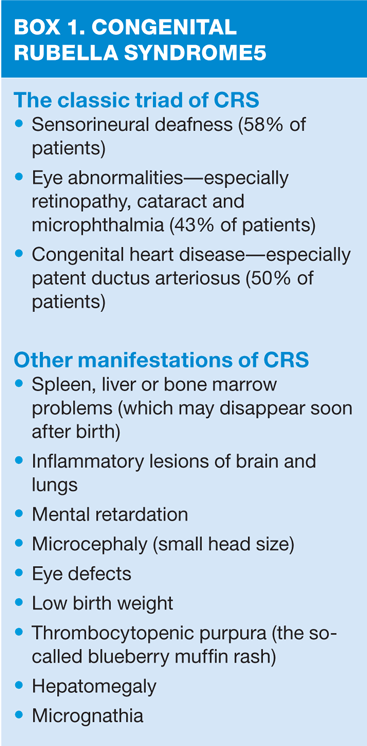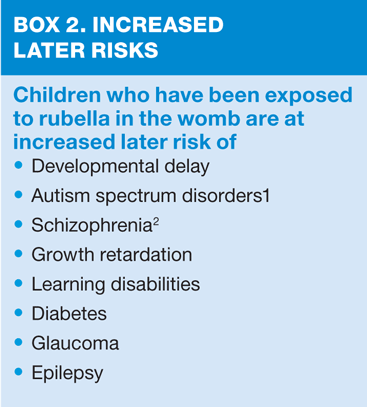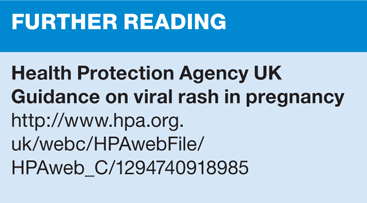Infectious diseases in children: Rubella
Dr Mary Lowth
Dr Mary Lowth
MA MB BChir FRCGP PGCME
GP and medical educationalist
Modern immunisations and vaccinations mean that many of the disease of childhood that used to be common are now seldom seen, unless there is an outbreak as we are currently seeing in the case of measles. As these diseases become less commonplace, a sense of complacency may undermine public willingness to accept vaccination for rubella — with potentially devastating consequences for the unborn child
Rubella — or German measles — is now uncommon in the UK, although since the fall in MMR uptake cases have increased and there were 57 notifications in the first half of 2012.1
Prior to vaccination being introduced rubella was common in children aged five to nine, occurring in epidemics every few years and affecting the majority during their childhood. In affected children it is a harmless, self-limiting disease. Its interest and importance lie not in the description of its fairly mild symptoms and course, but in its consequences for the developing fetus and the approach the world is taking to its control.
WHAT'S IN A NAME?
It was T S Eliot who wrote about the importance of naming cats, and Shakespeare who suggested that a rose might not be a rose if we called it a turnip. They were both making the point that when we name something we start to frame our understanding of it, and there begins confusion for rubella.
If we could start again, we would not name it German measles, because it is neither German nor measles, nor would we name it rubella, which sounds like rubeola, which means measles (an entirely unrelated disease). Moreover to compound the confusion, in Spanish rubeola also means rubella, and in Spanish measles is sarampion.
Nevertheless German measles is so named because it was first described by German physicians in the eighteenth century, and its alternative name of rubella is Latin for 'little red.'
DIAGNOSIS
Rubella is a mild viral illness with an incubation period of 2—3 weeks. It is caused by a togavirus, which multiplies in the nasopharynx and lymph glands. It is spread by respiratory droplet infection, and is not an easy disease to spot clinically. Suspect it if you see a rash in a child with swollen postauricular and occipital glands, particularly if unimmunised. The disease is notifiable so, if suspected, arrange for confirmation through serological testing.2
COURSE OF RUBELLA
Rubella is also known as 'three day measles' although it can last a little longer than this. It classically consists of a red rash, which may migrate gradually down the body. The typical swollen post auricular lymph and occipital lymph glands may precede this, as may fever, headache, malaise and coryza, but the disease can also be so mild as to pass unnoticed. As with many childhood diseases symptoms are slightly more pronounced in affected adults, who may experience arthralgia, sometimes with bruising and conjunctival injection.
Patients are infectious from about a week before the rash appears, until it disappears. However, generally they are not unwell, and there is no specific treatment other than symptomatic relief.
CONGENITAL RUBELLA SYNDROME
The rubella virus is teratogenic. It crosses the placenta even before the rash appears, and prevents fetal cells from dividing, leading to congenital rubella syndrome (CRS). CRS was first described in 1941 after an epidemic in Australia. The syndrome consists of a number of serious developmental problems which are listed in Box 1. Affected babies also secrete active rubella virus and are infectious for some months after birth.
The risk of the fetus being affected depends on the stage of pregnancy at which exposure occurs. Maternal infection in the four weeks prior to conception carries a substantial risk too, but risk is greatest in the first 11 weeks of pregnancy, when around 90% are affected. Many pregnancies spontaneously miscarry or are terminated.
From 11 to 16 weeks of pregnancy there is still a 20% chance of the syndrome, and from 16 to 20 weeks there is a risk of deafness. Beyond 20 weeks the disease does not affect fetal development.
There was a global pandemic of rubella between 1962 and 1965. In 1964—65, the United States had an estimated 12.5 million cases which led to 11,000 miscarriages or therapeutic abortions and 20,000 cases of CRS. Of these, 2,100 died as neonates, 12,000 were deaf, 3,580 were blind and 1,800 had developmental delay. In New York alone, CRS affected 1% of all births.3
ANTENATAL TESTING
All pregnant women in the UK are screened for rubella immunity early in pregnancy. Arguably this is too late — but it warns them, if negative, that they may be non-immune even if vaccinated and should avoid contact with anyone with a rash. They are offered vaccine post-natally.
Women consulting for preconception counseling or seeking infertility treatment are also checked for rubella immunity, which is not always complete or lifelong after receiving the rubella vaccine.
RUBELLA VACCINATION
Vaccination was introduced in 1970, with the aim of reducing the incidence of congenital rubella syndrome, which was up to 70 cases a year prior to this with about ten times as many pregnancies terminated due to rubella infection.1 Initially the vaccine was given only to girls, around the age of 14 as they approached sexual maturity, with the aim of directly targeting those at risk. Boys were not vaccinated at all. As a result the virus was able to circulate freely amongst younger children, and boys. This meant that those women who had missed the vaccine (which was given at school, often on a single day, missing girls who happened to be absent) or whose immunity had waned were vulnerable. The reduction in cases of congenital rubella was therefore not as great as had been hoped.
In 1998, with the introduction of MMR, vaccination moved to age 1 and included boys for the first time. This cut circulating rubella levels to a minimum although outbreaks do still occur, and we still have a large population of unvaccinated men.
RUBELLA AROUND THE WORLD
In 1996, 64 countries included rubella immunisation in their national programmes, covering 12% of the world's births.3 By 2011, the figures were 130 countries and 41%. Nevertheless, in most of sub Saharan Africa and South Asia routine vaccination is not yet in place.
In 1996, an estimated 22,000 babies were born with CRS in Africa, 46,000 in South-East Asia and 13,000 in the Western Pacific. Few countries in these regions have introduced rubella vaccine today, and the prevalence of CRS is likely to be similar to that almost 20 years ago. However, in March 2013 (thanks to the GAVI foundation and Bill Gates) Rwanda became the first country in sub Saharan Africa to introduce measles-rubella vaccine, and 49 African countries will be covered by 2020.4
Large-scale rubella vaccination globally has drastically reduced or practically eliminated rubella and CRS in many developed and some developing countries. Indeed, several European countries have eliminated rubella and CRS completely.
THE CHALLENGE TODAY
The importance of rubella in the UK is the need to promote immunisation as an essential personal and public health measure. Today, we see society in the developed world rejecting the idea of vaccination as a public duty for the common good. Increasingly autonomy has greater weight, and parents exercise the right to opt out — due to a sense of unease regarding MMR, and belief in a medical conspiracy to persuade them to take unacceptable individual risk for the common good. Parents may choose to see rubella as a harmless condition, particularly for boys, and as with measles, when we describe the risks of the diseases the public have forgotten we are accused of scaremongering. It is very much in all of our interests to eradicate rubella from our population and we in primary care remain at the front line of the fight to do so.
SUMMARY
The incidence of rubella in the world remains high. For the practice nurse in the UK it is an uncommon but important disease. We need to retain an awareness of the signs and symptoms, and an understanding of the consequences of infection in pregnancy in order to better promote the means to eradicate it for good. Practice nurses are in a good position to advise women who seek advice before conception to have their rubella status checked.
REFERENCES
1. BBC News August 2012: http://www.bbc.co.uk/news/health-19369365
2. Public Health England General Information on Rubella http://www.hpa.org.uk/web/HPAweb&HPAwebStandard/HPAweb_C/1195733749711
3. World Health Organisation : Rubella: http://www.who.int/immunisation/topics/rubella/en/index.html
4. United National Foundation news bulletin March 2013 http://www.unfoundation.org/news-and-media/press-releases/2013/over-700-million-children-to-be-protected.html
5. J.B. Hanshaw, J.A. Dudgeon, and W.C. Marshall. Viral diseases of the fetus and newborn. W.B. Saunders Co., Philadelphia, 1985
6. The GAVI foundation http://www.gavialliance.org/
Related articles
View all Articles



